Analyzing Language Acquisition in Children: Nativist, Interactionist
VerifiedAdded on 2023/06/10
|7
|1797
|311
Essay
AI Summary
This essay explores the process of language acquisition in children, focusing on three prominent theories: nativist, interactionist, and behaviorist. The nativist theory, championed by Noam Chomsky, posits that children possess an innate Language Acquisition Device (LAD) that enables them to construct their own syntaxes by absorbing and processing environmental stimuli. The interactionist theory emphasizes the combined influence of biological predispositions and social interactions in language development, highlighting the sociocultural model where children observe and internalize behaviors and linguistic patterns from their environment. Lastly, the behaviorist theory suggests that children learn language through imitation, rewards, and practice, mimicking the speech patterns of their parents and receiving positive reinforcement for correct imitations. Each theory is illustrated with relevant examples to provide a comprehensive understanding of the multifaceted nature of language acquisition in early childhood. Desklib offers this document, along with a wealth of other resources, to aid students in their academic pursuits.
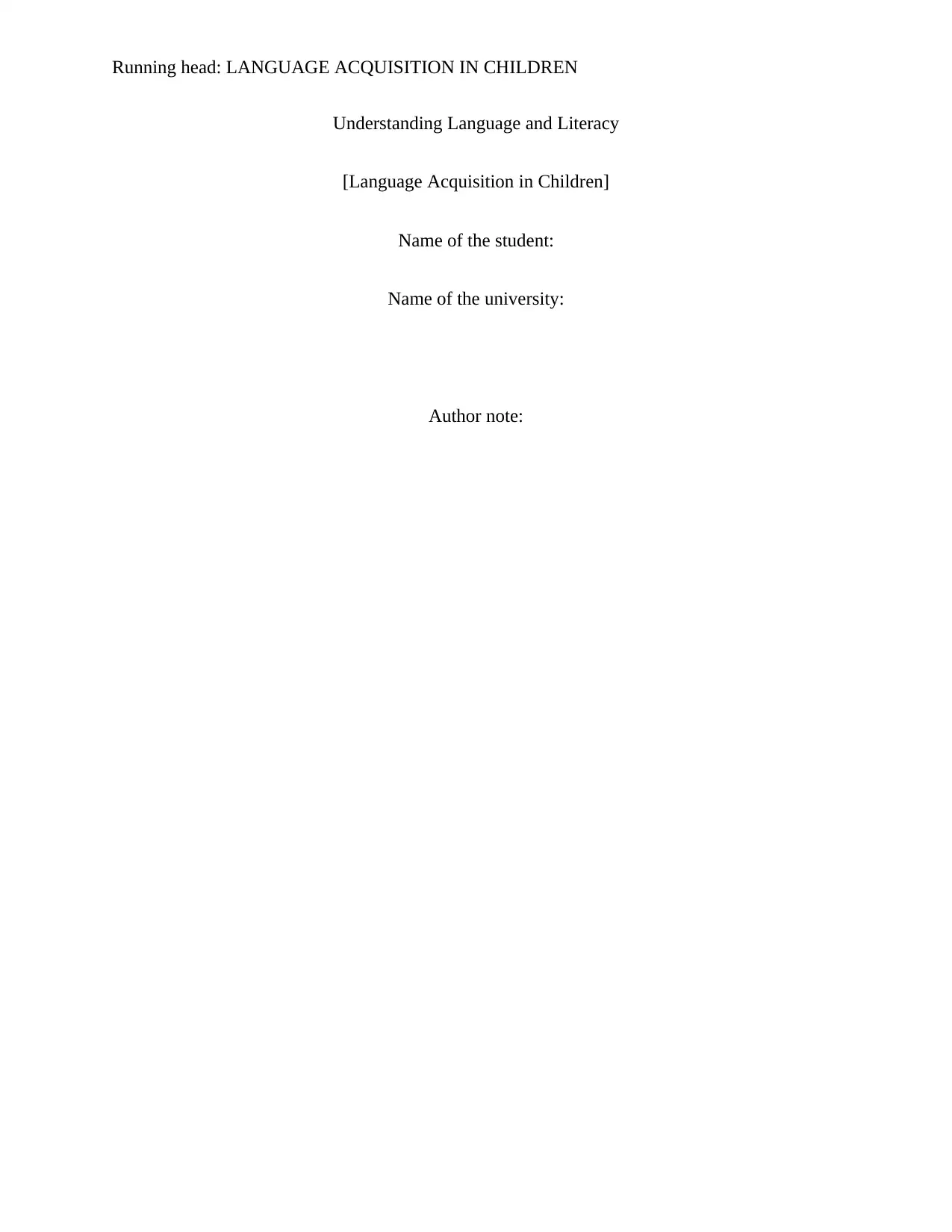
Running head: LANGUAGE ACQUISITION IN CHILDREN
Understanding Language and Literacy
[Language Acquisition in Children]
Name of the student:
Name of the university:
Author note:
Understanding Language and Literacy
[Language Acquisition in Children]
Name of the student:
Name of the university:
Author note:
Paraphrase This Document
Need a fresh take? Get an instant paraphrase of this document with our AI Paraphraser
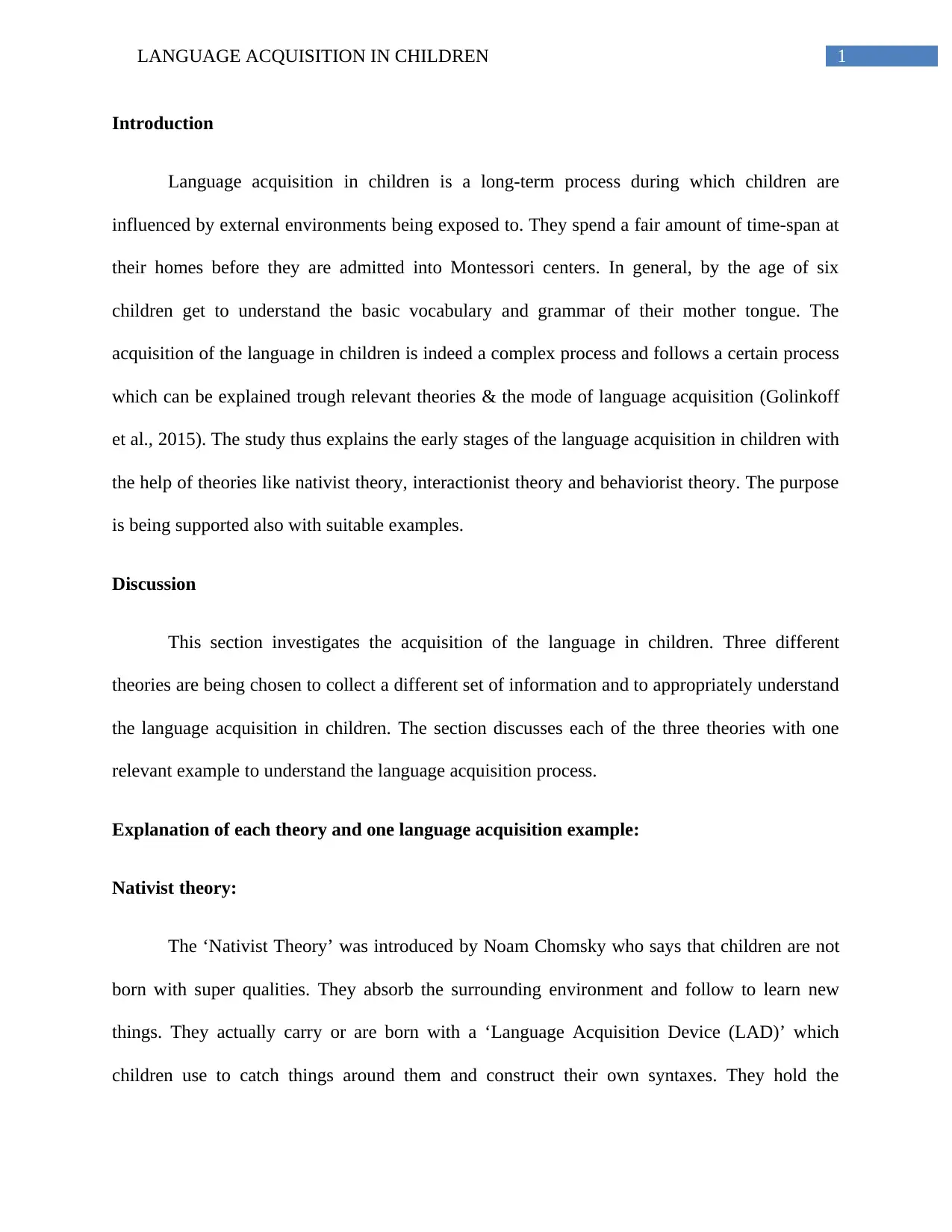
1LANGUAGE ACQUISITION IN CHILDREN
Introduction
Language acquisition in children is a long-term process during which children are
influenced by external environments being exposed to. They spend a fair amount of time-span at
their homes before they are admitted into Montessori centers. In general, by the age of six
children get to understand the basic vocabulary and grammar of their mother tongue. The
acquisition of the language in children is indeed a complex process and follows a certain process
which can be explained trough relevant theories & the mode of language acquisition (Golinkoff
et al., 2015). The study thus explains the early stages of the language acquisition in children with
the help of theories like nativist theory, interactionist theory and behaviorist theory. The purpose
is being supported also with suitable examples.
Discussion
This section investigates the acquisition of the language in children. Three different
theories are being chosen to collect a different set of information and to appropriately understand
the language acquisition in children. The section discusses each of the three theories with one
relevant example to understand the language acquisition process.
Explanation of each theory and one language acquisition example:
Nativist theory:
The ‘Nativist Theory’ was introduced by Noam Chomsky who says that children are not
born with super qualities. They absorb the surrounding environment and follow to learn new
things. They actually carry or are born with a ‘Language Acquisition Device (LAD)’ which
children use to catch things around them and construct their own syntaxes. They hold the
Introduction
Language acquisition in children is a long-term process during which children are
influenced by external environments being exposed to. They spend a fair amount of time-span at
their homes before they are admitted into Montessori centers. In general, by the age of six
children get to understand the basic vocabulary and grammar of their mother tongue. The
acquisition of the language in children is indeed a complex process and follows a certain process
which can be explained trough relevant theories & the mode of language acquisition (Golinkoff
et al., 2015). The study thus explains the early stages of the language acquisition in children with
the help of theories like nativist theory, interactionist theory and behaviorist theory. The purpose
is being supported also with suitable examples.
Discussion
This section investigates the acquisition of the language in children. Three different
theories are being chosen to collect a different set of information and to appropriately understand
the language acquisition in children. The section discusses each of the three theories with one
relevant example to understand the language acquisition process.
Explanation of each theory and one language acquisition example:
Nativist theory:
The ‘Nativist Theory’ was introduced by Noam Chomsky who says that children are not
born with super qualities. They absorb the surrounding environment and follow to learn new
things. They actually carry or are born with a ‘Language Acquisition Device (LAD)’ which
children use to catch things around them and construct their own syntaxes. They hold the
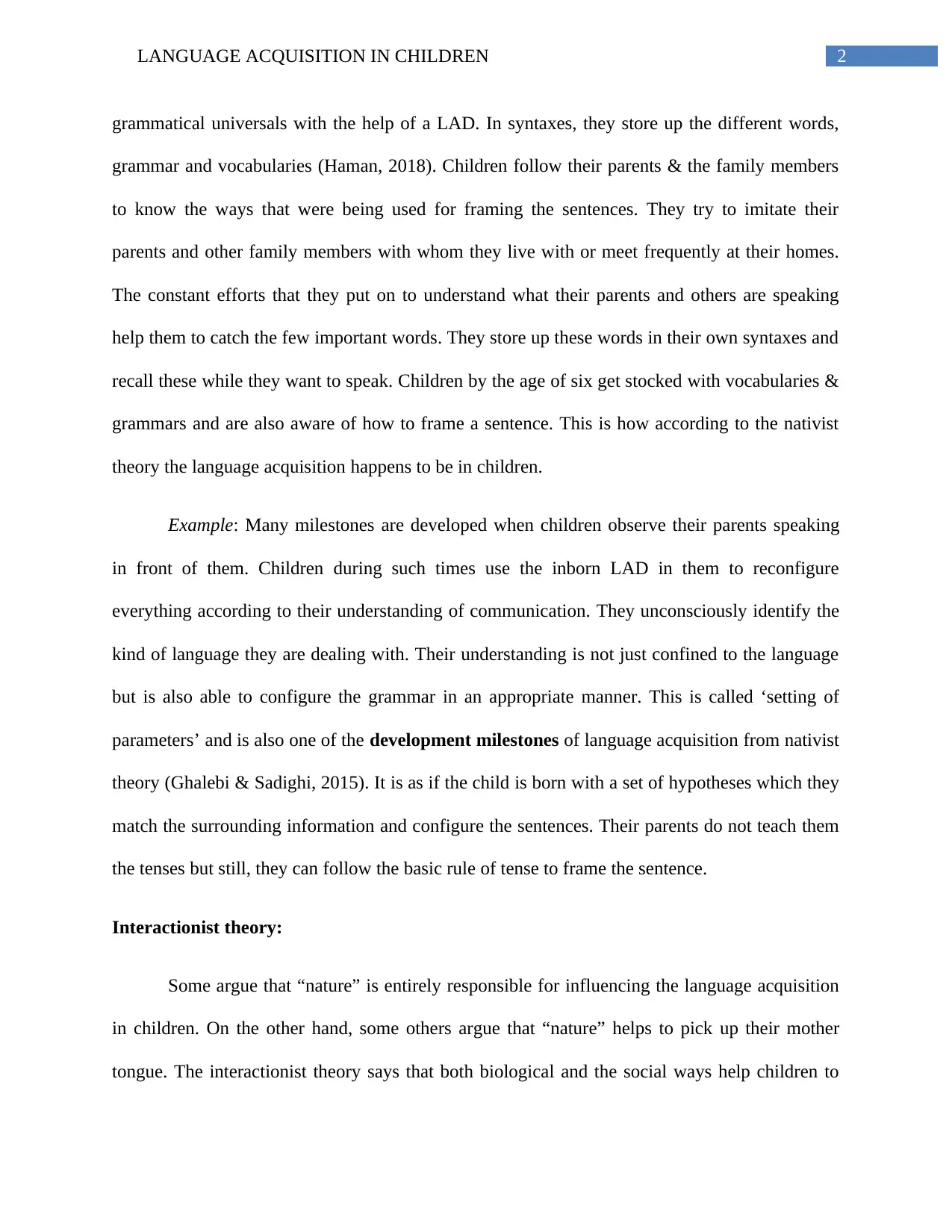
2LANGUAGE ACQUISITION IN CHILDREN
grammatical universals with the help of a LAD. In syntaxes, they store up the different words,
grammar and vocabularies (Haman, 2018). Children follow their parents & the family members
to know the ways that were being used for framing the sentences. They try to imitate their
parents and other family members with whom they live with or meet frequently at their homes.
The constant efforts that they put on to understand what their parents and others are speaking
help them to catch the few important words. They store up these words in their own syntaxes and
recall these while they want to speak. Children by the age of six get stocked with vocabularies &
grammars and are also aware of how to frame a sentence. This is how according to the nativist
theory the language acquisition happens to be in children.
Example: Many milestones are developed when children observe their parents speaking
in front of them. Children during such times use the inborn LAD in them to reconfigure
everything according to their understanding of communication. They unconsciously identify the
kind of language they are dealing with. Their understanding is not just confined to the language
but is also able to configure the grammar in an appropriate manner. This is called ‘setting of
parameters’ and is also one of the development milestones of language acquisition from nativist
theory (Ghalebi & Sadighi, 2015). It is as if the child is born with a set of hypotheses which they
match the surrounding information and configure the sentences. Their parents do not teach them
the tenses but still, they can follow the basic rule of tense to frame the sentence.
Interactionist theory:
Some argue that “nature” is entirely responsible for influencing the language acquisition
in children. On the other hand, some others argue that “nature” helps to pick up their mother
tongue. The interactionist theory says that both biological and the social ways help children to
grammatical universals with the help of a LAD. In syntaxes, they store up the different words,
grammar and vocabularies (Haman, 2018). Children follow their parents & the family members
to know the ways that were being used for framing the sentences. They try to imitate their
parents and other family members with whom they live with or meet frequently at their homes.
The constant efforts that they put on to understand what their parents and others are speaking
help them to catch the few important words. They store up these words in their own syntaxes and
recall these while they want to speak. Children by the age of six get stocked with vocabularies &
grammars and are also aware of how to frame a sentence. This is how according to the nativist
theory the language acquisition happens to be in children.
Example: Many milestones are developed when children observe their parents speaking
in front of them. Children during such times use the inborn LAD in them to reconfigure
everything according to their understanding of communication. They unconsciously identify the
kind of language they are dealing with. Their understanding is not just confined to the language
but is also able to configure the grammar in an appropriate manner. This is called ‘setting of
parameters’ and is also one of the development milestones of language acquisition from nativist
theory (Ghalebi & Sadighi, 2015). It is as if the child is born with a set of hypotheses which they
match the surrounding information and configure the sentences. Their parents do not teach them
the tenses but still, they can follow the basic rule of tense to frame the sentence.
Interactionist theory:
Some argue that “nature” is entirely responsible for influencing the language acquisition
in children. On the other hand, some others argue that “nature” helps to pick up their mother
tongue. The interactionist theory says that both biological and the social ways help children to
⊘ This is a preview!⊘
Do you want full access?
Subscribe today to unlock all pages.

Trusted by 1+ million students worldwide
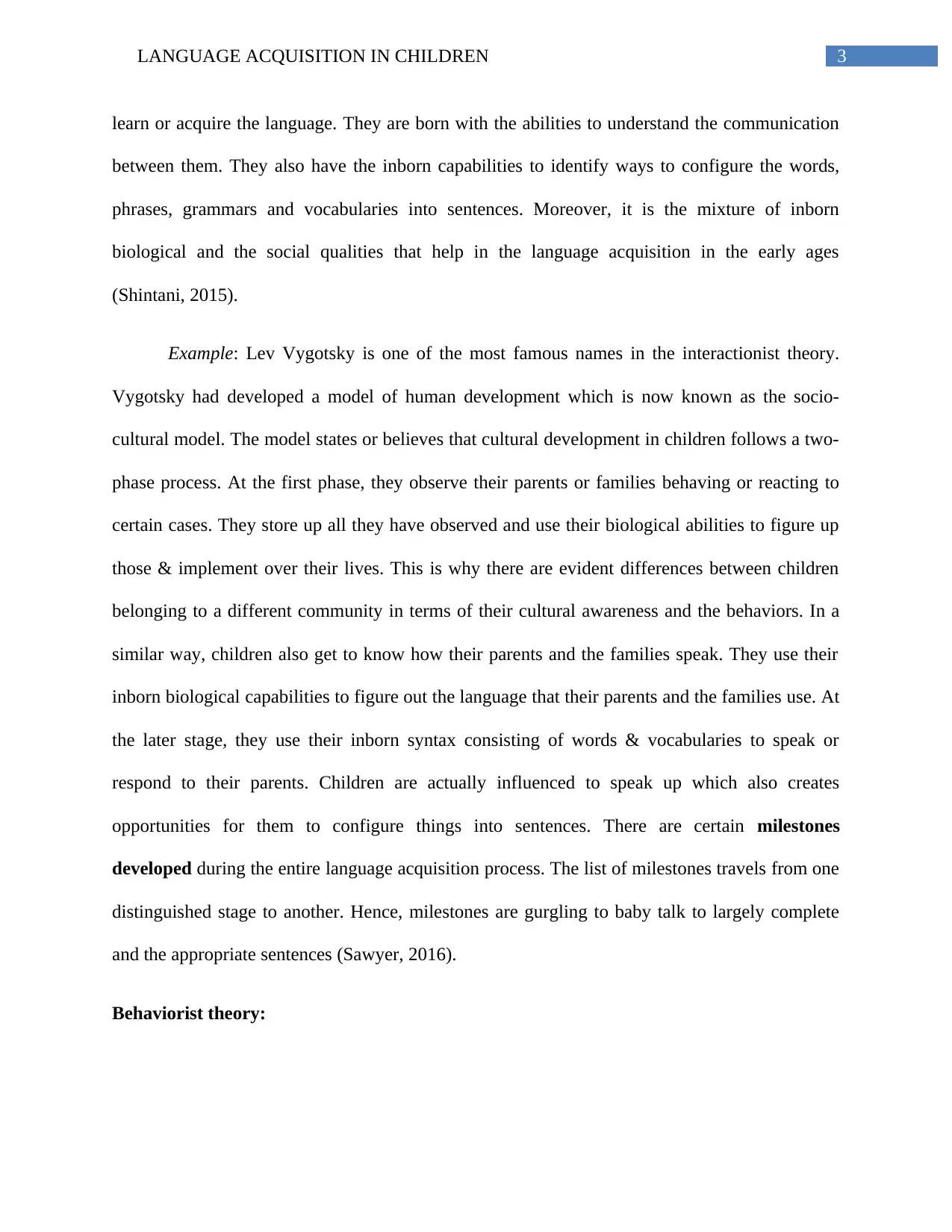
3LANGUAGE ACQUISITION IN CHILDREN
learn or acquire the language. They are born with the abilities to understand the communication
between them. They also have the inborn capabilities to identify ways to configure the words,
phrases, grammars and vocabularies into sentences. Moreover, it is the mixture of inborn
biological and the social qualities that help in the language acquisition in the early ages
(Shintani, 2015).
Example: Lev Vygotsky is one of the most famous names in the interactionist theory.
Vygotsky had developed a model of human development which is now known as the socio-
cultural model. The model states or believes that cultural development in children follows a two-
phase process. At the first phase, they observe their parents or families behaving or reacting to
certain cases. They store up all they have observed and use their biological abilities to figure up
those & implement over their lives. This is why there are evident differences between children
belonging to a different community in terms of their cultural awareness and the behaviors. In a
similar way, children also get to know how their parents and the families speak. They use their
inborn biological capabilities to figure out the language that their parents and the families use. At
the later stage, they use their inborn syntax consisting of words & vocabularies to speak or
respond to their parents. Children are actually influenced to speak up which also creates
opportunities for them to configure things into sentences. There are certain milestones
developed during the entire language acquisition process. The list of milestones travels from one
distinguished stage to another. Hence, milestones are gurgling to baby talk to largely complete
and the appropriate sentences (Sawyer, 2016).
Behaviorist theory:
learn or acquire the language. They are born with the abilities to understand the communication
between them. They also have the inborn capabilities to identify ways to configure the words,
phrases, grammars and vocabularies into sentences. Moreover, it is the mixture of inborn
biological and the social qualities that help in the language acquisition in the early ages
(Shintani, 2015).
Example: Lev Vygotsky is one of the most famous names in the interactionist theory.
Vygotsky had developed a model of human development which is now known as the socio-
cultural model. The model states or believes that cultural development in children follows a two-
phase process. At the first phase, they observe their parents or families behaving or reacting to
certain cases. They store up all they have observed and use their biological abilities to figure up
those & implement over their lives. This is why there are evident differences between children
belonging to a different community in terms of their cultural awareness and the behaviors. In a
similar way, children also get to know how their parents and the families speak. They use their
inborn biological capabilities to figure out the language that their parents and the families use. At
the later stage, they use their inborn syntax consisting of words & vocabularies to speak or
respond to their parents. Children are actually influenced to speak up which also creates
opportunities for them to configure things into sentences. There are certain milestones
developed during the entire language acquisition process. The list of milestones travels from one
distinguished stage to another. Hence, milestones are gurgling to baby talk to largely complete
and the appropriate sentences (Sawyer, 2016).
Behaviorist theory:
Paraphrase This Document
Need a fresh take? Get an instant paraphrase of this document with our AI Paraphraser
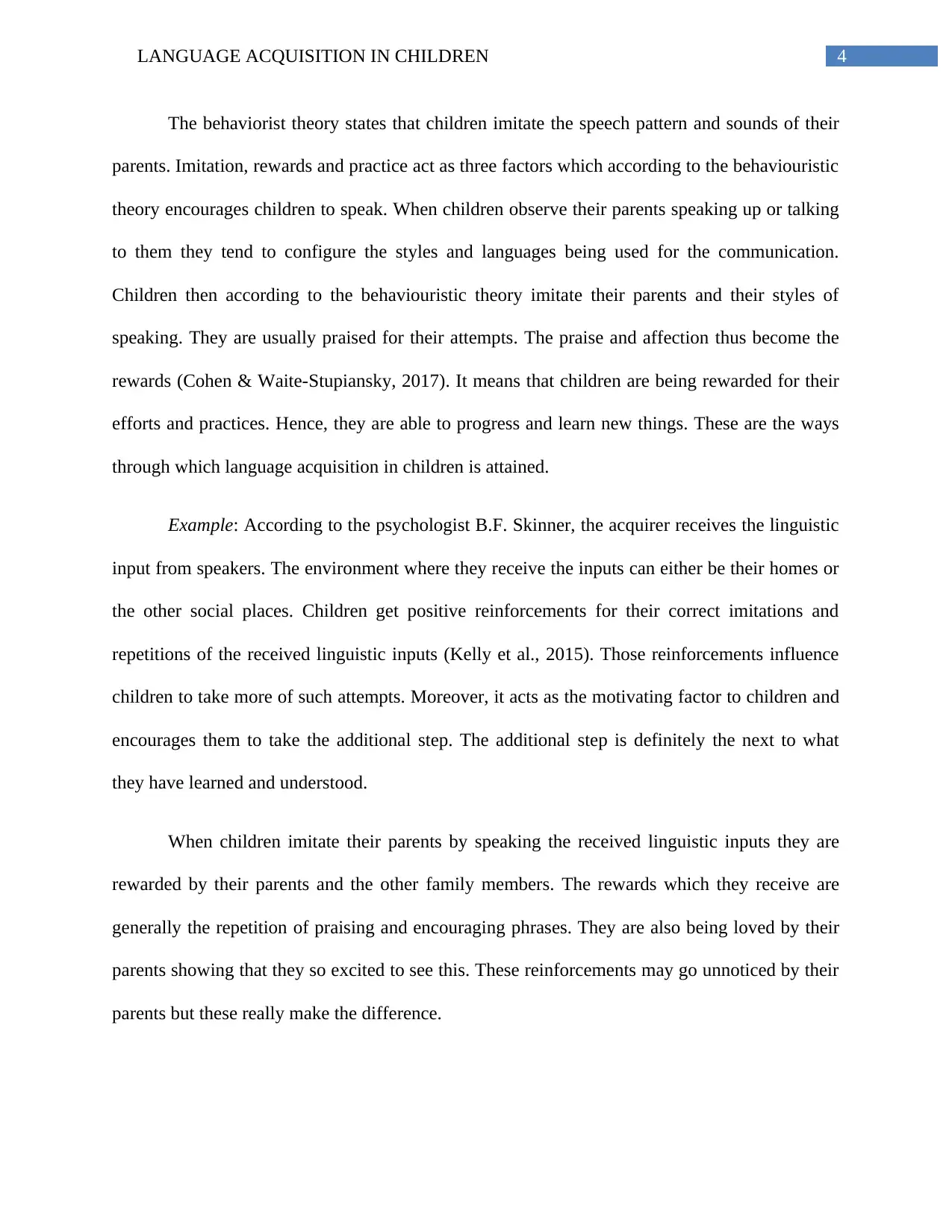
4LANGUAGE ACQUISITION IN CHILDREN
The behaviorist theory states that children imitate the speech pattern and sounds of their
parents. Imitation, rewards and practice act as three factors which according to the behaviouristic
theory encourages children to speak. When children observe their parents speaking up or talking
to them they tend to configure the styles and languages being used for the communication.
Children then according to the behaviouristic theory imitate their parents and their styles of
speaking. They are usually praised for their attempts. The praise and affection thus become the
rewards (Cohen & Waite-Stupiansky, 2017). It means that children are being rewarded for their
efforts and practices. Hence, they are able to progress and learn new things. These are the ways
through which language acquisition in children is attained.
Example: According to the psychologist B.F. Skinner, the acquirer receives the linguistic
input from speakers. The environment where they receive the inputs can either be their homes or
the other social places. Children get positive reinforcements for their correct imitations and
repetitions of the received linguistic inputs (Kelly et al., 2015). Those reinforcements influence
children to take more of such attempts. Moreover, it acts as the motivating factor to children and
encourages them to take the additional step. The additional step is definitely the next to what
they have learned and understood.
When children imitate their parents by speaking the received linguistic inputs they are
rewarded by their parents and the other family members. The rewards which they receive are
generally the repetition of praising and encouraging phrases. They are also being loved by their
parents showing that they so excited to see this. These reinforcements may go unnoticed by their
parents but these really make the difference.
The behaviorist theory states that children imitate the speech pattern and sounds of their
parents. Imitation, rewards and practice act as three factors which according to the behaviouristic
theory encourages children to speak. When children observe their parents speaking up or talking
to them they tend to configure the styles and languages being used for the communication.
Children then according to the behaviouristic theory imitate their parents and their styles of
speaking. They are usually praised for their attempts. The praise and affection thus become the
rewards (Cohen & Waite-Stupiansky, 2017). It means that children are being rewarded for their
efforts and practices. Hence, they are able to progress and learn new things. These are the ways
through which language acquisition in children is attained.
Example: According to the psychologist B.F. Skinner, the acquirer receives the linguistic
input from speakers. The environment where they receive the inputs can either be their homes or
the other social places. Children get positive reinforcements for their correct imitations and
repetitions of the received linguistic inputs (Kelly et al., 2015). Those reinforcements influence
children to take more of such attempts. Moreover, it acts as the motivating factor to children and
encourages them to take the additional step. The additional step is definitely the next to what
they have learned and understood.
When children imitate their parents by speaking the received linguistic inputs they are
rewarded by their parents and the other family members. The rewards which they receive are
generally the repetition of praising and encouraging phrases. They are also being loved by their
parents showing that they so excited to see this. These reinforcements may go unnoticed by their
parents but these really make the difference.
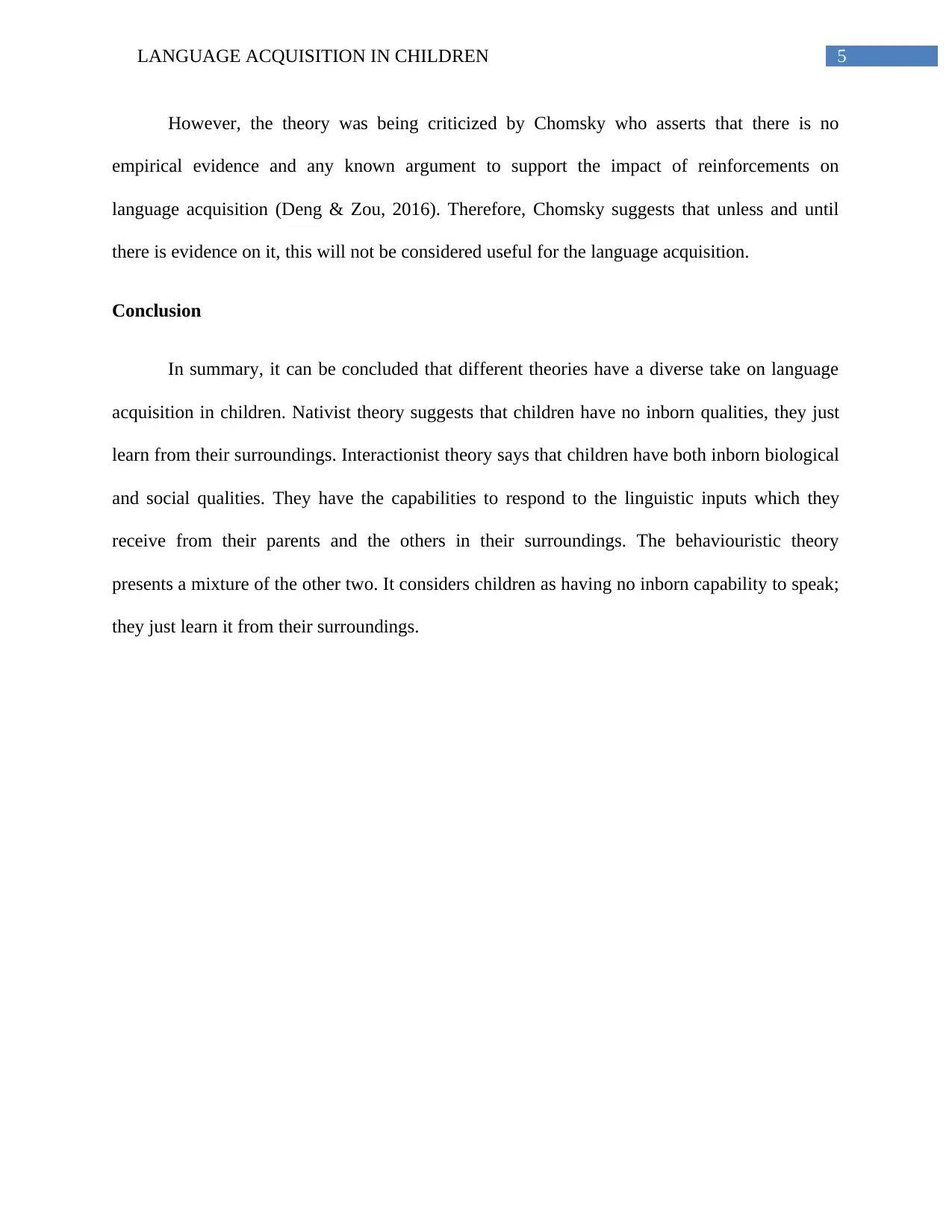
5LANGUAGE ACQUISITION IN CHILDREN
However, the theory was being criticized by Chomsky who asserts that there is no
empirical evidence and any known argument to support the impact of reinforcements on
language acquisition (Deng & Zou, 2016). Therefore, Chomsky suggests that unless and until
there is evidence on it, this will not be considered useful for the language acquisition.
Conclusion
In summary, it can be concluded that different theories have a diverse take on language
acquisition in children. Nativist theory suggests that children have no inborn qualities, they just
learn from their surroundings. Interactionist theory says that children have both inborn biological
and social qualities. They have the capabilities to respond to the linguistic inputs which they
receive from their parents and the others in their surroundings. The behaviouristic theory
presents a mixture of the other two. It considers children as having no inborn capability to speak;
they just learn it from their surroundings.
However, the theory was being criticized by Chomsky who asserts that there is no
empirical evidence and any known argument to support the impact of reinforcements on
language acquisition (Deng & Zou, 2016). Therefore, Chomsky suggests that unless and until
there is evidence on it, this will not be considered useful for the language acquisition.
Conclusion
In summary, it can be concluded that different theories have a diverse take on language
acquisition in children. Nativist theory suggests that children have no inborn qualities, they just
learn from their surroundings. Interactionist theory says that children have both inborn biological
and social qualities. They have the capabilities to respond to the linguistic inputs which they
receive from their parents and the others in their surroundings. The behaviouristic theory
presents a mixture of the other two. It considers children as having no inborn capability to speak;
they just learn it from their surroundings.
⊘ This is a preview!⊘
Do you want full access?
Subscribe today to unlock all pages.

Trusted by 1+ million students worldwide
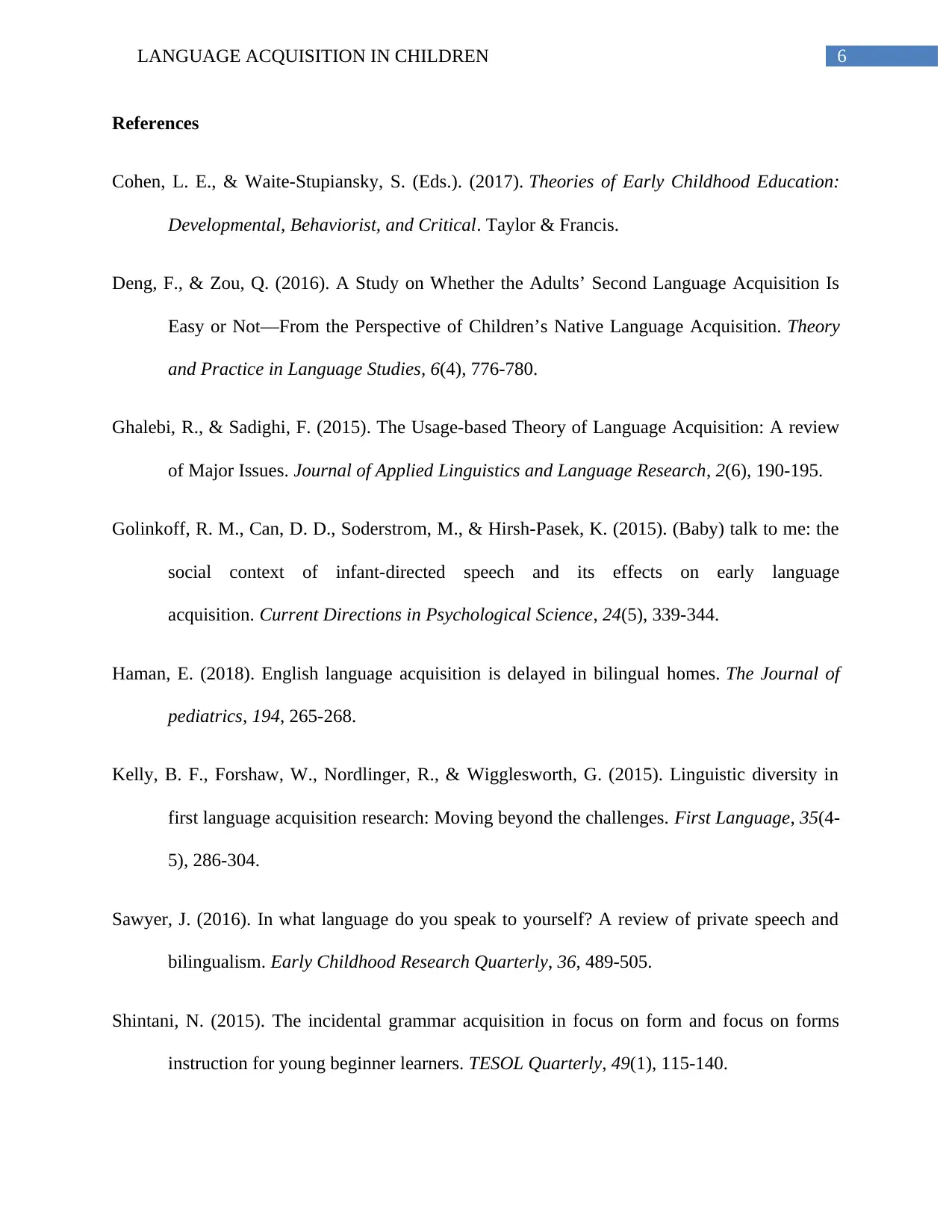
6LANGUAGE ACQUISITION IN CHILDREN
References
Cohen, L. E., & Waite-Stupiansky, S. (Eds.). (2017). Theories of Early Childhood Education:
Developmental, Behaviorist, and Critical. Taylor & Francis.
Deng, F., & Zou, Q. (2016). A Study on Whether the Adults’ Second Language Acquisition Is
Easy or Not—From the Perspective of Children’s Native Language Acquisition. Theory
and Practice in Language Studies, 6(4), 776-780.
Ghalebi, R., & Sadighi, F. (2015). The Usage-based Theory of Language Acquisition: A review
of Major Issues. Journal of Applied Linguistics and Language Research, 2(6), 190-195.
Golinkoff, R. M., Can, D. D., Soderstrom, M., & Hirsh-Pasek, K. (2015). (Baby) talk to me: the
social context of infant-directed speech and its effects on early language
acquisition. Current Directions in Psychological Science, 24(5), 339-344.
Haman, E. (2018). English language acquisition is delayed in bilingual homes. The Journal of
pediatrics, 194, 265-268.
Kelly, B. F., Forshaw, W., Nordlinger, R., & Wigglesworth, G. (2015). Linguistic diversity in
first language acquisition research: Moving beyond the challenges. First Language, 35(4-
5), 286-304.
Sawyer, J. (2016). In what language do you speak to yourself? A review of private speech and
bilingualism. Early Childhood Research Quarterly, 36, 489-505.
Shintani, N. (2015). The incidental grammar acquisition in focus on form and focus on forms
instruction for young beginner learners. TESOL Quarterly, 49(1), 115-140.
References
Cohen, L. E., & Waite-Stupiansky, S. (Eds.). (2017). Theories of Early Childhood Education:
Developmental, Behaviorist, and Critical. Taylor & Francis.
Deng, F., & Zou, Q. (2016). A Study on Whether the Adults’ Second Language Acquisition Is
Easy or Not—From the Perspective of Children’s Native Language Acquisition. Theory
and Practice in Language Studies, 6(4), 776-780.
Ghalebi, R., & Sadighi, F. (2015). The Usage-based Theory of Language Acquisition: A review
of Major Issues. Journal of Applied Linguistics and Language Research, 2(6), 190-195.
Golinkoff, R. M., Can, D. D., Soderstrom, M., & Hirsh-Pasek, K. (2015). (Baby) talk to me: the
social context of infant-directed speech and its effects on early language
acquisition. Current Directions in Psychological Science, 24(5), 339-344.
Haman, E. (2018). English language acquisition is delayed in bilingual homes. The Journal of
pediatrics, 194, 265-268.
Kelly, B. F., Forshaw, W., Nordlinger, R., & Wigglesworth, G. (2015). Linguistic diversity in
first language acquisition research: Moving beyond the challenges. First Language, 35(4-
5), 286-304.
Sawyer, J. (2016). In what language do you speak to yourself? A review of private speech and
bilingualism. Early Childhood Research Quarterly, 36, 489-505.
Shintani, N. (2015). The incidental grammar acquisition in focus on form and focus on forms
instruction for young beginner learners. TESOL Quarterly, 49(1), 115-140.
1 out of 7
Related Documents
Your All-in-One AI-Powered Toolkit for Academic Success.
+13062052269
info@desklib.com
Available 24*7 on WhatsApp / Email
![[object Object]](/_next/static/media/star-bottom.7253800d.svg)
Unlock your academic potential
Copyright © 2020–2025 A2Z Services. All Rights Reserved. Developed and managed by ZUCOL.





